Math 152B
Midterm III
Key
Please do all
of the following problems. All work
and all answers must be done on your own paper.
Credit earned will be based on the steps that you show that lead to the
final solution. Good Luck!
Problem
1:
Write
down the quadratic formula
![]()
Problem
2:
Aislynn
paid $26 for two adult tickets and three children’s tickets to the movies.
Kevin paid $48 for 4 adult tickets and 5 children’s tickets.
What is the price of an adult ticket?
Let x be the price of the adult ticket and
Let y be the price of the children's ticket
Then the equation that corresponds to Aislynn's purchase is
2x + 3y = 26
The equation the corresponds to Kevin's purchase is
4x + 5y = 48
4x + 6y = 52 Multiplying the first equation by 2
-
or
y = 4
4x + 5(4) = 48 Plugging 4 into the first equation
4x = 28 Subtracting 20 from both sides
x = 7 Dividing by 4
Hence the price of the adult ticket is $7
Problem
3:
Sketch
the solution set for the following inequalities
A
3x + y < 6
3x + y = 6
x | y
0 |
6
2
| 0
Next use the test point (0,0):
3(0) + 0 < 6
is a false statement, hence (0,0) is not in the region. We thus shade in the other half.
Notice that the inequality is "<" telling us that the line is not included and should be drawn as dashed.
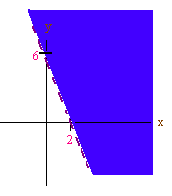
B.
x
> 2
We can recognize this region as the set of all points that are to the right of the vertical line
x = 2
Notice
again, since the inequality is ">" we draw the line dashed.
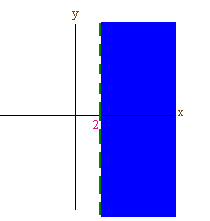
C.
2x + y > 0
2x + y = 0
We will need to select a point that is not an intercept since the origin is on the line.
x | y
0 |
0
1
| -2
Since (0,0) lies on the line, we use the alternative test point (1,0).
2(1) + (0) > 0
is a true statement, hence (1,0) is in the region. We thus shade in this half.
Notice that the inequality is ">" telling us that the line is included and should be drawn as dashed.
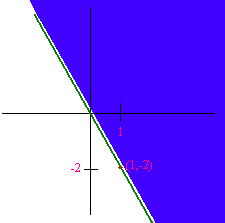
Problem
4:
Use
the discriminant to determine the nature of the roots of the following
quadratics.
A. 2x2 + 3x + 4 = 0
The discriminant is
32 - 4(2)(4) = 9 - 32 < 0
Since
the discriminant is negative, we can conclude that there are no real roots, only
two complex conjugate roots.
B.
3x2
+ x - 4 = 0
The discriminant is
12 - 4(3)(-4) = 1 + 48 > 0
Since the discriminant is positive, we can conclude that there are two distinct real roots.
C.
4354324532453x2 + 2x + 6798797698766 = 0
The discriminant is two difficult to compute by hand, however we see that the second coefficient is small in comparison to the other two coefficients, that is
22 - 4(big)(big) = 4 - very big < 0
Since
the discriminant is negative, we can conclude that there are no real roots, only
two complex conjugate roots.
Problem 5: Solve the following system.
2x - 3y = 13
x + 2y
= -4
We use the method of substitution. The second equation yields
x = -4 - 2y Subtracting 2y from both sides
Now substitute the above into the first equation
2(-4 - 2y) - 3y = 13
-8 - 4y - 3y = 13 Multiplying through
-8 - 7y = 13 Combining like terms
-7y = 21 Adding 8 to both sides
y = -3 Dividing both sides by 7
Now substitute in -3 for y
x = -4 - 2(-3)
x = -4 + 6 = 2
Hence the solution is (2,-3)
Problem
6:
Solve
the equation by using the factoring or root method.
A) 10x2 = 13x + 3
First bring all terms to the left hand side
10x2 - 13x - 3 = 0
There are two ways of completing this problem. The first is to use the quadratic formula
a = 10 b = -13 c = -3
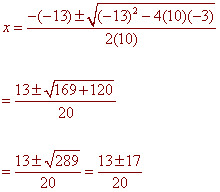
Hence
13 + 17
x =
20
or
13 - 17
x =
20
We get x = 3/2 or x = -1/5
Alternatively, we can factor using the AC method:
AC = -30
The two numbers that multiply to -30 and add to -13 are
(-15,2)
We now rewrite
= 5x(2x - 3) + 1(2x - 3) Factoring by grouping
= (5x + 1)(2x - 3) = 0
Hence
5x + 1 = 0 or 2x - 3 = 0
x = -1/5 or x = 3/2
B)
2x2 + 15 = 11
To solve this, there is no "x" term, so we can use the square root property:
2x2 = -4 Subtracting 15 from both sides
x2 = -2 Dividing both sides by two
x = ![]()
![]() i
Taking the square root of both sides and pulling
out an i
i
Taking the square root of both sides and pulling
out an i
Problem
7:
Solve the following by completing the square
5x2 - 20x + 21 = 0
5(x2 - 4x) + 21 = 0 Pulling out the 5 from the first two terms
Now calculate the magic number (b/2)2
(-4/2)2 = (-2)2 = 4
5(x2 - 4x + 4 - 4) + 21 = 0 Adding and subtracting the magic number 4
5[(x - 2)2 - 4] + 21 = 0 Factoring the first three terms
5(x - 2)2 - 20 + 21 = 0 Distributing the 5 through
5(x - 2)2 + 1 = 0 Adding the numbers
5(x - 2)2 = -1 Adding the numbers
(x - 2)2 = -1/5 Dividing both sides by 5
x - 2 = ![]() i
/
i
/![]() Taking
the square root of both sides and pulling out an i
Taking
the square root of both sides and pulling out an i
x = 2 ![]() i
/
i
/![]() Adding
2 to both sides
Adding
2 to both sides
x = 2 ![]() i
i![]() /5
Rationalizing
the denominator
/5
Rationalizing
the denominator
Problem
8:
Solve
the following by any method
A)
6x2 + 5x - 4 = 0
We use the quadratic formula with
a = 6, b = 5, c = -4
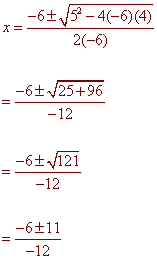
So that
x = 1/2 + 11/12 or x = 1/2 - 11/12
Notice that we could have instead used the AC method to factor.
B)
2x3 - 18x
= 0
We factor:
2x(x2 - 9) = 0 Pulling out the greatest common factor
2x(x - 3)(x + 3) = 0 Difference of squares
x = 0, x = 3, or x = -3 Zero product formula
Problem
9
The
pressure p in pounds per square foot of a wind is directly proportional to the
square of the velocity v of he wind. If
a 10-mi/hr wind produces a pressure of 0.3 lb/ft2, what pressure will
a 100-mi/hr wind produce?
This is a variation problem. The first sentence implies
p = kv2
The second sentence tells us
0.3 = k(10)2 When v = 10 p = 0.3
0.3 = 100k
k = 0.3/100 = 0.003 Dividing both sides by 100
p = 0.003v2 Substituting k = 0.003 back into the original equation
Now we want to know what p is when v = 100
p = 0.003(100)2 Substituting 100 in for v
p = 0.003(10,000) = 30
A 100 mile per hour wind will produce a pressure of 30lb/ft2
Problem 10
A) Suppose that (1,2) and (3,5) are both solutions to the system of equations
ax + by = c
dx + ey = f
Then the two equations represent the same line
True, since if otherwise the lines would either be parallel (have no points of intersection) or intersect in one point.
B) If ![]() - 1 is a root of the quadratic equation
- 1 is a root of the quadratic equation
ax2 + bx + c = 0
then
![]() + 1 is also a root.
+ 1 is also a root.
False, the other root is the conjugate, which is
-![]() - 1
- 1